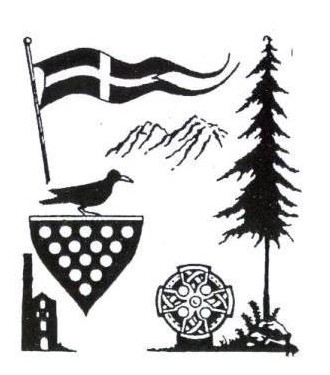|
|
Pine
tree and mountains
= Symbols of the American Pacific Northwest
St Piran flag banner = St. Piran is specifically the patron Saint of “Tinners” and generally considered that of Cornwall as well. The white on black is assumed to represent the pure white tin streaming from the black ore and/or the pure light of God's truth streaming in the darkness Stack house = Old mine engine houses with their tall chimneys are sometimes called "Cornish Cathedrals”. They are part of the machinery, the framework for the great steam beam engines. These engines pumped water from great depths and hoisted the ore won by endless labor from the hard rock. Unlike the Welsh coalmines, where fire and explosion were the biggest dangers, the most serious problem in Cornish mines was flooding, because of their great depth below the natural water tables.
|
|
Traditional Cornish cross = These Celtic crosses are also found abundantly in Wales, Ireland, and Scotland. They date from the period of the Celtic Church (5th to 10th centuries). There are some thirty-two of these crosses in Cornwall with a variety of inscriptions including the Ogham, Latin, and Anglo Saxon languages Bird = The Chough (pronounced "chuff") is Cornwall's national bird. It is an endangered species (like the Cornish!). There are new colonies being bred around Penwith and Lizard, with natural colonies on the cliffs of southwest Ireland. The Chough is very easily disturbed by human activity with the valuable eggs threatened by theft.. This crow-like member of the jay family, a highly intelligent bird, is easily distinguished by its bright red legs and curved red beaks. Cornish writer Les Merton in his booklet, The Spirit of A King, has celebrated the Choca (in Cornish) in drama, prose, poetry, fact, and fiction. Triangle with 15 circles = the shield comes from the Cornish coat
of arms. The circles are flat disks and represent Bezants, mediaeval
solidus gold coins that took their name from the ancient city of Byzantium in
the Byzantium Empire of Asia Minor. One story tells that the King of England was
holding the Duke of Cornwall, Richard the Lionheart, in the Tower of London
prison. The King set the ransom for his release at 15 Besants, a ridiculously
large sum (several hundred thousand dollars in today's money). The Cornish
people raised the money by popular subscription and Richard was released.
The fifteen Bezants represent Cornish unity and from this event came the
Cornish motto, “One and All.” Historically
the number of Bezants varies. The
first time the triangle shape of Bezants is recorded and known as “in pile”,
and only ten in number, is on the tomb of Elizabeth I in Westminster Abbey while
the first known familiar fifteen-pattern is in the Great Hall at Lostwithial
from the 1600’s. The fifteen Bezants in pile on a black shield is the
exclusive icon of the Duke of Cornwall. Sources:
Bard Yowann Byghan, Michael
Kiernan, and
Cornish Heraldry & Symbolism, by D. Endean Ivall, 1988 Dick Colenso Page
Updated 07/30/2010
|
|
